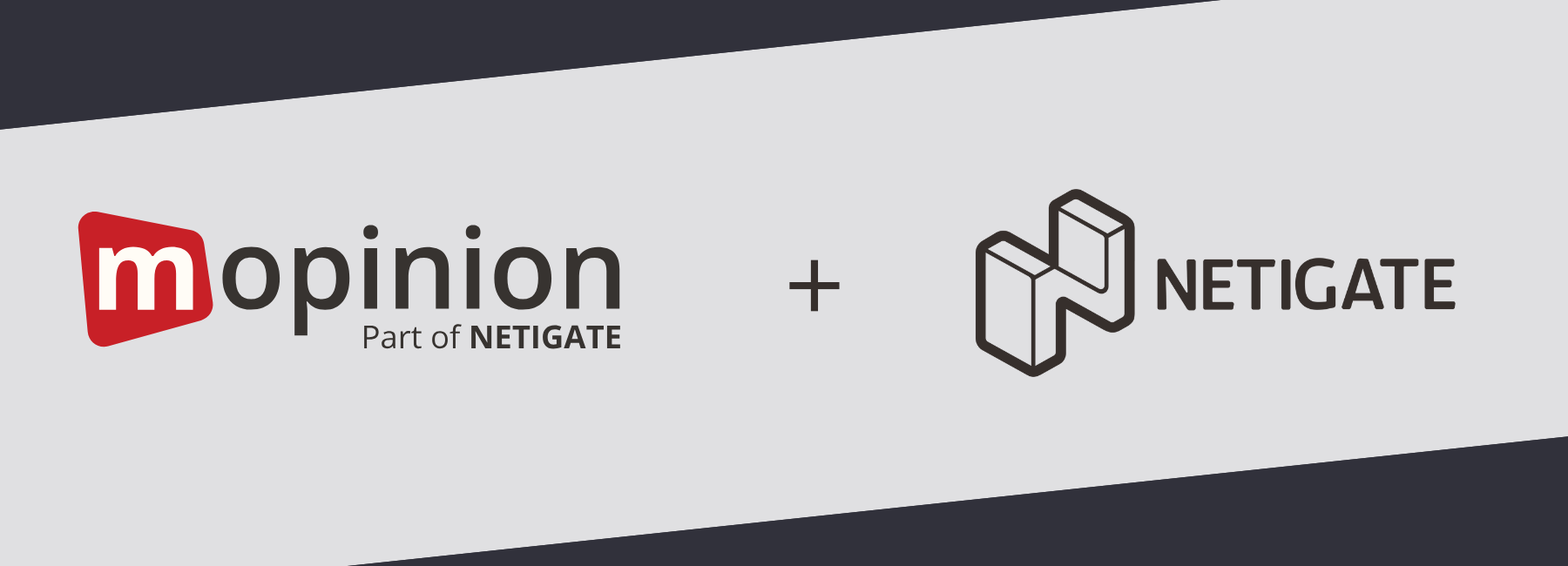Many retailers have embraced ecommerce and sell their products both online and offline. And they want to offer an excellent customer experience in their webshop to match the experience in the physical store. One way to do so is by asking customers for feedback, to learn more about their expectations and needs.
Retailers have started collecting digital feedback to get a better understanding of their online customers. In turn, they make improvements where it’s needed leading to a better ecommerce customer experience and eventually more conversions. Ka-ching!
Whether you’re already collecting feedback or you’re new to the game, learning from other companies can always be useful and inspirational. In this article, we will share some great insights from Calvin Klein, de Bijenkorf, Intergamma, Leroy Merlin and more and how they use feedback to their advantage.
Mopinion’s feedback software is used for multiple purposes, and we have great companies using our software in remarkable ways. In this article, you’ll learn all about new and innovative ways to collect feedback straight from our users. Sharing is caring, amirite? We hope this blog gives you new inspiration for your own feedback strategy.
To add some structure to this article, we’ll be looking at the different stages of a customer feedback strategy, including the customer feedback management steps:
- What are the goals with customer feedback?
- How to collect customer feedback? (Collect)
- What to do with the collected feedback? (Analyse)
- What are the results from taking action based on feedback? (Take action)
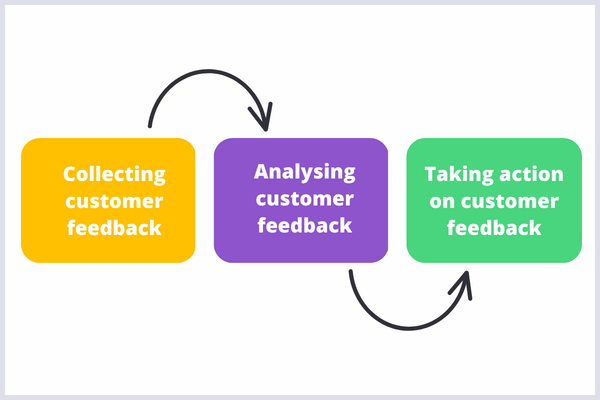
What are the goals with customer feedback?
Like with so many things, you start with a goal. What do you want to achieve by collecting feedback on your digital channels? Many of our customers seek to improve customer experience and become more customer-centric, and in turn increase conversions. It’s important to have a clear goal that all stakeholders agree upon. Let’s take a look at what our customers want to achieve with feedback.
We’ll start with a huge ecommerce company, Leroy Merlin, the leading brand in the home improvement and DIY market in France. Their Customer Experience Manager Nicolas Haese explains: “Listening to the online VoC is part of our DNA”.
Leroy Merlin has always put a lot of emphasis on listening to their customers, and they wanted to expand this to their digital channels using customer feedback. They want to give their visitors the opportunity to express themselves throughout the online journey.
Our objectives are relatively simple: collect feedback from our online users, measure the satisfaction of these users and ensure the improvement of their satisfaction. Thanks to Mopinion, we believe we can achieve these strategic goals.
Nicolas Haese, Customer Experience Manager at Leroy Merlin France
GO Sport Group is a market leader in the sports equipment market in France. One of its core values is customer orientation. Their goal with feedback is to improve the customer journey and the NPS on their website. They want to get closer to their customers and understand what they think while offering an efficient website that reflects their target audience.
For several years now, GO Sport has aimed to be much more than a simple distributor of sporting goods. Our ambition is to really support our customers in their sports. We want to go far beyond a simple shopping experience, whether online or in store.
Benjamin Courgeon, E-commerce and Marketplace Offer Manager at GO Sport
De Bijenkorf is a high-end retail brand with multiple department stores in the Netherlands. Their goal is to show the value of customer feedback in the process of product & service development and make it a part of everyone’s daily routine in improving the customer experience.
De Bijenkorf’s online vision is to offer an online shopping experience that matches its premium standard provided to customers in stores.
We want to give our customers all the tools they need to reach their goals on our online platforms. Be it from tracking their orders to ordering their preferred sneakers, their expectations need to be met online. Therefore we’re focusing heavily on providing self-service and online assistance when and where our customers need it. The customer should have multiple options to find answers to what they’re looking for.
Wouter Brackel, UX Design Lead at de Bijenkorf

Feedback form on the website of de Bijenkorf
Another large retail chain in the Netherlands is HEMA. HEMA’s ambition has always been to “keep things simple” for their customers – online and offline. And in order to reflect this concept of simplicity on their online channels, HEMA knew that the experience had to be easy and clear-cut.
Our customers are central to our organisation, which means in order to serve them to the best of our ability, we need to know and understand what they want and what works well for them in an online environment.
Floor Hickmann, UX Manager at HEMA
These are just a few examples of the goals our customers have and are achieving with feedback. Let’s go to the next step, collecting the feedback.
How to collect customer feedback? (Collect)
Once a clear goal has been agreed upon (stick to it!), it’s time to actually start collecting the feedback. Questions like ‘What will we ask our customers?’, ‘When and where will we ask for feedback?’ and ‘How often will we ask for feedback?’ need to be answered. There’s a lot of things to consider but it depends on your goal, your audience, industry, and much more. So we can’t tell you exactly what you need to do. But we can tell you how some of our customers do this. And you can also look at our list of 45 ecommerce survey questions to ask.
Leroy Merlin uses the CSAT as their standard metric to measure the progress towards their goal. They have a feedback form placed on different pages on the websites and the follow-up questions are based on the answers of the customer.
“The metric that best meets our objectives is the CSAT (Customer Satisfaction Score) indicator. We use it in different places across the site.” Our visitors have the possibility to enter his/her level of satisfaction on a scale of 1 to 5 and depending on his/her rating, questions will be generated while remaining relevant to the rating they’ve given. The feedback responses collected will help identify customer frustrations, take action to improve the online user experience and therefore increase the conversion rate.”
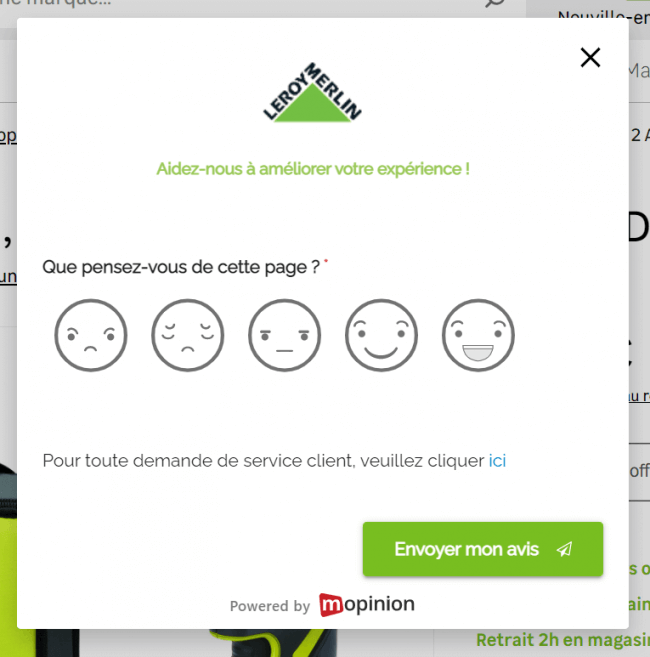
Feedback form on the website of Leroy Merlin
SportScheck, a large sports retailer from the DACH region, uses feedback to optimise the website so that customers can find the products and information they need. That is why they collect feedback on all product descriptions. They use an embedded form that asks ‘How would you rate this product description?’ with the answer options ranging from 1 to 5 stars. They also use feedback to monitor the search function. At the bottom of the search results, visitors will find a survey asking ‘How satisfied are you with the search result?’ (see image below).
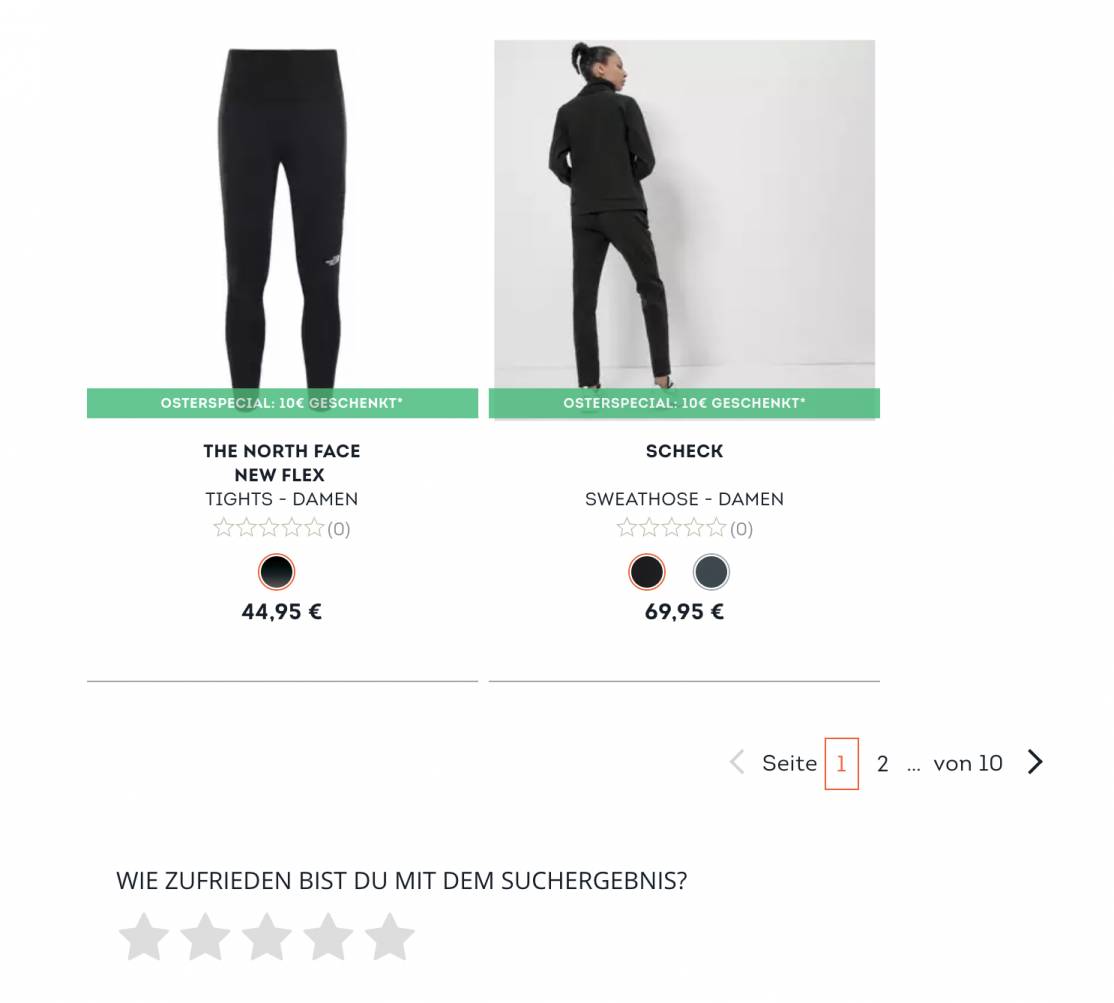
Feedback form on the website of SportScheck on the search results
Calvin Klein, the well-known fashion brand famous for its underwear, collects feedback to get qualitative and emotional data from their customers (next to the quantitative data they collect).
In order to come up with valid ideas that move the site forward, I believe 80% of the effort is simply to listen to your customers. They talk to you through their actions, interactions, engagements and other data they leave behind. However, this can leave room for interpretation as well as emotions being hard to track. This is why we need a way to get in touch with our consumer, so we can answer the “why” to the “what”.
Davy Schuyt, CRO Manager at Calvin Klein
Davy Schuyt explains that they have multiple surveys running at the same time. There is a permanent passive feedback form on the website, including the payment page to check for payment problems and a form on the confirmation page to ask the customer about their experience. Forms are also deployed when new campaigns are launched. About the length of the survey:
“The shorter a survey, the more chance someone fills it in. The longer the survey, the more information we get. Generally we keep the questions to a max of 3, but we always include a field for open input. It’s important that we can categorise the answers, but more important that people don’t feel like they have to change their opinion to fit a predetermined answer.”
Calvin Klein uses quantitative data to determine where and when visitors are most likely to run into an issue. The surveys are deployed only when it’s the right person, right time and right place, thanks to Mopinion’s targeting capabilities. This makes giving feedback relevant for the customer and gives Calvin Klein the detailed insights they need.
“People move about the website very differently based on their goals and personal backgrounds, making it increasingly more important to be able to ask the right question at the right time. Mopinion allows us to target on a granular level, allowing us to dive deeper into certain topics.”
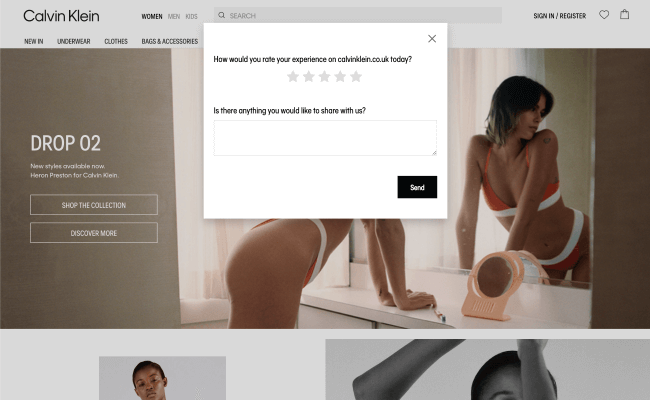
Feedback form on the website of Calvin Klein
Intergamma is the organisation behind two large DIY hardware stores in the Netherlands, Gamma and Karwei. For them, the customer must continue to come first in all physical and online stores. They approached the feedback questions with care before implementing forms on their website. Some words of advice from Erik van Houwelingen, Lead CRO and Web Analyst at Intergamma, about collecting feedback:
The trickiest part was formulating good questions and answer options that matched the moment and the type of survey trigger. At first this does not seem very difficult, but it is actually a very challenging task. Using the answers to the open questions in the feedback form forms we had running, we were able to map out which answer options would be suitable for the multiple choice questions we would later add to the forms (e.g. What is the purpose of your visit?) In fact, for the first two weeks, we were only busy fine-tuning the questions and the interactions with the forms.
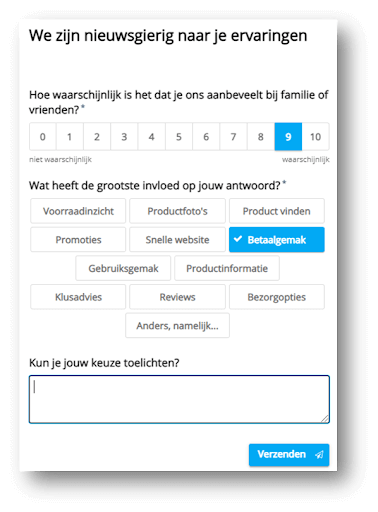
Answer options in the feedback form on the website of Gamma
Although collecting feedback seems like an easy step, there are quite some things to consider. We recommend taking the time to think about which metric to use to track your progress and how you’re going to measure that, what and how many questions you’re going to ask and when and where you will ask for feedback. Many customers have standard metrics in place that are measured with a default feedback form on every page on a website or app. Then they have temporary feedback forms for a specific campaign, product or project to get more in-depth feedback.
What to do with the collected feedback? (Analyse)
The second step is analysing the feedback that comes in. Many ecommerce companies have thousands of feedback items coming in per day. To make sense of this data they need to bring feedback data together in a clear and digestible manner. In Mopinion you can do both quantitative and qualitative data analysis of the incoming feedback. Let’s see how our customers analyse feedback data.
Omoda, a Dutch shoe store chain with online and physical stores, uses the qualitative analytics feature Text Analytics in Mopinion.
The text analytics that Mopinion offers really adds value for us. The incoming feedback is scanned for subject or keywords, enabling us to immediately identify who the feedback is relevant for and subsequently get passed on to the right department.
Elodie Janse, Customer Experience Manager at Omoda
Calvin Klein is very structured when it comes to analysing their feedback data. “Every two months we analyse the Confirmation Page, Payment Page and General Feedback surveys. We compare this with previous months to see if persistent errors are diminishing and which new ones are arising. We tend to analyse one-off surveys as soon as possible and use those to fuel our testing roadmap and future campaign implementations.”
All of these insights are then shared company-wide, since a lot of the information is applicable across the board.
Intergamma also shines some light on how they analyse feedback. “Having all of the feedback available in one place made it very easy to analyse the data. For example, if the situation requires all feedback from shopping cart visitors, or all feedback from visitors with a low Customer Effort Effort Score, this can easily be filtered out, regardless of how it was collected.”
They praise the filter options and dashboards in Mopinion. “Furthermore you can quickly see via the dashboard when an important KPI falls or rises and should you want to know more about why this is happening, you can click on, for example, the detractors in an NPS chart and you are redirected to the (detailed) feedback items. All this makes it easy for different departments to get actionable information from the tool. Thanks to the improved visualisation and easy accessibility of the feedback items through charts in the dashboard and the various filter options, we noticed that more of our team members were ‘clicking around’ in the Mopinion software.”
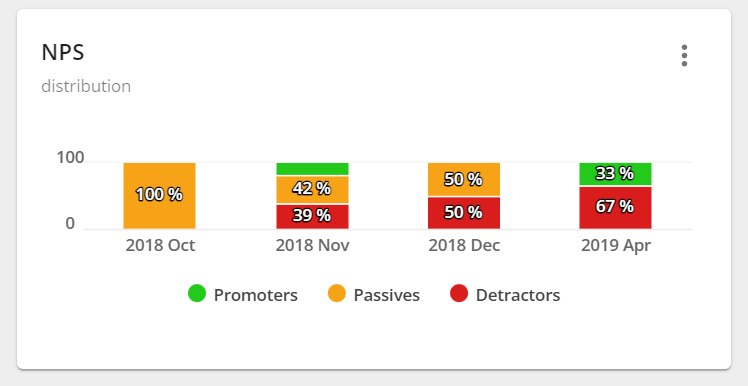
Example of a chart to track your most important KPI’s
Both Intergamma and Calvin Klein pointed out that feedback is easily shareable with other teams, making feedback helpful for more than just their own team. Thanks to the newly released Access Groups, it’s even easier to share feedback with the right person and teams.
HEMA tells us that they use the dashboard to pinpoint trends in the feedback. For example, they track the GCR and CES over time in charts to see if there are significant changes which they need to follow up on. The dashboard helps them run through the feedback in a structured way. As Floor Hickmann explains:
We are gathering a lot of feedback from both our current website and new website (which is still in the beta phase) and comparing metrics such as GCR and CES in the dashboard. This is really interesting because now we can see the difference in numbers.
What are the results from taking action based on feedback? (Take action)
The last step is actually using the feedback and making improvements. We also refer to this as closing the feedback loop. Our customers have used incoming feedback to their advantage which has led to some great improvements on their digital channels and the customer experience. Let’s take a look at some of the results they have achieved.
Conrad, a multinational retailer in electronics, has been using Mopinion for years and feedback has uncovered many issues such as:
- The payment module did not function optimally in various countries
- The connection to the middleware did not always work well
- Issue with adding a promotional code
- Older accounts were unable to complete the ordering process
- They were able to solve and prioritise common problems

Feedback form on the website of Conrad
Thanks to the feedback, we were able to identify what needed to be improved, which wasn’t all that bad. The search function also did not work well, which is something that we already knew, but we were not satisfied with the speed of improvement. By collecting feedback on this, we were able to make this a priority for the development team, so that the improvement of the search engine was given a higher priority.
Matthijs Gaikema, Head of Analysis & Control at Conrad Electronic Benelux B.V.
Again, we see that feedback can be used by other departments and it even helps raise priority for pressing issues.
As part of their data-driven decision making, Calvin Klein uses feedback to feed their experimentation program.
Listening to our customers allows us to test solutions specific to the problems they are facing. This in turn increases the success rate of our experimentation program significantly, as well as allows us to provide other teams with emotional data, rather than simply numbers.
One very practical case of how feedback helped them improve: “We found a big credit card payment issue that was caused simply by an unexpected glitch in the user interface – no bugs involved! After solving it we saw a massive increase in successful payments again.”
Feedback even shows them how important certain social and environmental topics are. While their model images are greatly appreciated, more diversity in body types is something people respond to very well, which is a large focus for Calvin Klein. “As time goes on, we also see more and more callouts towards sustainability – something we’re already doing, but wanting to make more visible.”
De Bijenkorf has reached their goal of providing their customers with the tools they need to achieve their goals online, for example through self-service possibilities. They also explain that feedback has directly impacted their revenue.
We now have more awareness of customer feedback as it relates to our product development. It has provided us with insights that enable us to further develop our self-service strategy on the website. By applying touchpoint metrics, we can easily gain detailed insights into the success of the project and link those insights directly with revenue growth.
Intergamma also achieved quite some nice results with Mopinion. A very practical example:
Because we collected a large amount of feedback in a short period of time, and so many people within the company were able to search through the feedback from their own domain, a number of bugs (that were easy to repair) immediately became apparent. For example, there was a form on our website used for customising a screen door. Visitors were required to enter decimal points into the form, rather than commas, which proved to cause a lot of confusion among our visitors, leaving them stuck in the process. This was something we quickly fixed, of course!
Special case: Positive effect of asking for feedback on conversions!
Intergamma has not only tested different questions and the effect of question order. They have even tested the effect of asking for feedback on conversions. They wanted to know if asking for feedback would cause distraction or even irritation for the visitor, also referred to as feedback fatigue.
As Erik van Houwelingen explains: “We conducted an A/B test where 50% of traffic was exposed to a feedback form, and the other 50% was not. The A/B test showed that conversions actually increased (significantly) when visitors were exposed to a feedback form.”
This led us to the conclusion that asking for feedback provides for both indirect and direct optimisation.
Conclusion
We’re extremely happy to see that our customers get so much value from their customers’ feedback, using Mopinion. And we’re grateful that they wanted to share their insights with us and inspire others.
With ever increasing customer expectations, such as personalized offers and services,it’s safe to say that getting qualitative data from your customers helps you along the way to meet those expectations. Especially in the highly competitive ecommerce space. You need to understand your customers and give them the opportunity to share their thoughts and emotions. We’re here to make that easy.
Ready to see Mopinion in action?
Want to learn more about Mopinion’s all-in-1 user feedback platform? Don’t be shy and take our software for a spin! Do you prefer it a bit more personal? Just book a demo. One of our feedback pro’s will guide you through the software and answer any questions you may have.





